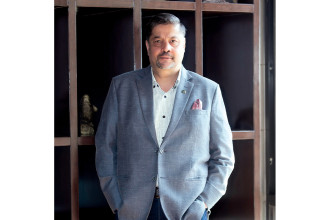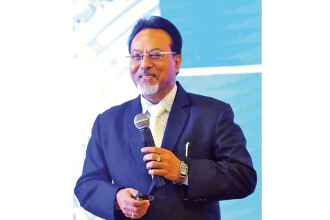.jpg)
Prajesh Bikram Thapa
CEO, Chilime Engineering and Services Co Ltd (ChesCo)
Prajesh Bikram Thapa, Chief Executive Officer of Chilime Engineering and Services Co Ltd (ChesCo), has been in the hydropower sector for the last two decades. He says, “I joined Chilime as a Senior Contract Engineer and am the CEO of the company for the last five-and-a-half years.” Thapa says that in these 20 years he has been fortunate to witness an entire project lifecycle from identifying a project to its completion. “As a result, I am aware of all the requirements at every stage of the project,” he states.
Chilime is a pioneer hydropower company in introducing shares for the local people of the project site. It currently has five subsidiary companies. Thapa informs that Chilime hydropower project (22.1 MW) holds a prestigious history of constructing a project with its own engineering design and management, site supervision including operations and maintenance at a time when there weren’t many hydropower projects in Nepal.
At present, Chilime is a name to reckon with in the domestic hydropower sector. In this issue of Business 360, we spoke to Thapa about aspects of the hydropower sector of the country, the potential, the challenges and the impending IPO strategy of Chilime. Excerpts:
Nepal has significant untapped hydropower potential. How do you see the role of innovative technologies and approaches in harnessing this potential while considering environmental and social impacts?
First of all, hydropower itself is a renewable source of energy. It has great potential not only for the country but also the area in which the project is constructed. The importance of hydropower has become paramount environmentally as well. It is a sustainable form of energy when looked at through the climate lens or livelihood or social impact. Hydropower is a form of energy that contributes significantly to each and every sector.
There has been a lot of evolution ecologically, and in the equipment used to construct a hydropower project. The improved design of the equipment is to minimise environmental degradation and maximise social impacts.
Can you discuss the challenges and opportunities associated with developing small-scale hydropower projects in rural areas of Nepal where infrastructure and accessibility might be limited?
There are unlimited difficulties and challenges when it comes to construction and sustainability of a hydropower project. The first challenge is the infrastructure itself as most projects are located in rural areas and we lack proper road access making it difficult to take our equipment to the sites. Secondly, the environmental challenges have always been a question. There are rare trees that we might have to cut down. The environment assessment team takes substantial time to study the area and the risks related to it. We, as a company, do not want to hamper the environment through our projects.
The third challenge and which I think is the most important is the finance. Hydropower projects can range from small to huge, but regardless of the size of the project, the process approval of the site itself takes a lot of time to complete. As a result, considerable amount of budget is required to go forward with hydropower projects.
With regard to opportunities, there is economic upliftment of the region where the project is constructed. It helps in poverty alleviation and it also uplifts the environment around it. Before the construction of the project, there is an environmental impact assessment. And for any problem, we ensure taking mitigation measures. There are also plenty of training programmes for skilled human resources who are usually locals of that area. Also, once the project is initiated, there is instant development in the region as facilities begin to reach the respective rural areas.
Given Nepal’s vulnerability to seismic activity, how do you address engineering and construction challenges to ensure the safety and reliability of hydropower projects in seismic zones?
It is a prerequisite part of engineering. During the different phases of engineering, we have to conduct a feasibility study and there is a seismic hazard mapping as well. The mapping for every region is different and you have to take into consideration the risks according to the results. This assessment is one of the key elements. We have to include the seismic value in our reports which determines the size of the project. We optimise the project through these studies and the challenges are addressed, studying the reliability of the zones.
What is the third-party rating compliance of Chilime consulting as you go to IPO?
We do rating through a third party which is an independent company. The third party has a set of checklists that has to be followed and it also checks the risk of the company, the history and the financial transparency and timely audit are checked of the past four to five years. There are projections of the future projects as well to see how credible and reliable the company is.
We have to think about the financial aspect the most when constructing any infrastructure. So, IPOs come into play when people are diving in big products, and there has to be a code of conduct and corporate governance. Under corporate governance, one has to have financial transparency to apply for an IPO.
Chilemi has been in the greens. How have you achieved this and what is it that you did differently to ensure profits?
It is the dedication of the people in the office to make sure that the company is making profits through the projects. Similarly, Nepal has been having constant infrastructure advancement for development purposes.
Also, the consultation services are mostly provided by international companies and we are consistently working on all the aspects ensuring that the needs and requirements are fulfilled as per international standards. We are also trying to contain the capital in the country itself by providing services as needed.
Hence, our credibility by completing the projects has shown that we as a Nepal-based company are able to provide the standard results. Because of it we are getting the job done and the consistency has helped the company to grow. Overall, we believe in providing quality service within the stipulated time and budget.
How do you rate the government’s regulations and monitoring of hydropower companies? What are the loopholes that increase risks?
There is continuous improvement in government, nevertheless, there is always room to improve. But what we have to keep in consideration is the process of evolution in the hydropower sector. There are times where Nepal’s policy has changed abruptly and made it difficult to continue any development work. If we look at history, the first hydropower project was established in Pharping in 1911 and for the next 30-40 years, we were using 300 to 500 MW capacity electricity. After the changes in the late 90s, when democracy was introduced, there was a free market economy where the private sector started to enter the sector. The switch to the private sector has contributed to the development of hydropower immensely from 300-500 MW to what we now have which is 3,000 MW of capacity in the last 20-25 years.
To get any hydropower project endorsed we have to visit eight ministries, 29 departments and 300 tables. We require the coordination of eight ministers. The projects have to go through plenty of processing to even be eligible for environment assessment. The bureaucracy should be vigilant but at the same time also be ready to work on time as per the requirements. I believe that if they just work according to the regulations and complete the work without procrastinating, it will boost the way government entities work and progress. The main challenge is environment strategy which can take around one to two years to complete but the monitoring part is extremely weak and needs improvement so that projects can operate smoothly.
Hydropower projects in general are said to have a dismal performance, however the government has initiated policies for it and there are hydropower projects that intend to raise Rs 100 billion from the general public over the next five years. Your views.
For any kind of development work, capital infusion is a prerequisite. Like any project, a hydropower project needs a huge amount of financial support and funding is important. But we have to make sure what will be the source of such funding and one of the sources is the public. Also, from the development aspect, sometimes Rs 100 billion too might not be enough for the project as we might not know the amount and time it might take to be completed.
The project takes a lengthy time and all the processes are equally financially extensive. Hence, the only way a project is able to raise capital is through the public. It is mutually beneficial as well. The people and the state both benefit from such projects as people can rely on the credibility a project provides and the projects can sustain and give its result with the help of the investment.
How do you view Nepal’s future in hydroelectricity? And the thrust on electricity export? What are the challenges and what works?
Competition is everywhere as all the stakeholders want to benefit from hydropower projects but we have to look at this sector with a bird’s eye view. Let us take the hydropower sector as a pie. Instead of dividing it into parts and competing to take a bigger portion, we have to increase its magnitude and work together. Again, from the perspective of development, Nepal’s potential has just started to enter the market. A lot of the potential and probability is yet to be discovered. Hence, taking it positively, we all have to work together to make it a capital generating source in the near future.
There are many direct and indirect benefits for people. Direct benefit is that through the hydropower project people have access to electricity in the most rural of areas. According to statistics, access to electricity has jumped from 60% to 96% across Nepal. The remaining percent where access to electricity is still lacking are areas which are very difficult to reach. One small village may have only a couple of houses and to provide electricity there we might have to spend around Rs 2 crores to provide electricity to only one house and their electricity consumption won’t be even near 20 units.
Hydropower companies are developed on Build Own Operate and Transfer model. What happens to shareholders after a project is handed back to the government or if it shuts down?
This is a model implemented by the government itself. It’s a national level policy. After the tenure of the projects, they are handed to the government. At the end of the day, resources that we use are of the country. So, we use the resources and make them applicable all around the country and for the people. Lately, a lot of issues have been brewing about it and I believe that any issue regarding such natural resources should be discussed and decided by the state with the help of experts and changes should come from the policy level.
Here, the company curates the project and the investment that the people have made is going to help the company throughout the process and at the end, the government is just taking over the project and its progress, not the company. If the company themselves diversify and have opened other avenues, it means that the investment has been used and has not gone to waste. Here, the basic concept is that the investment is within the company and is used to expand and grow. Thus, the investment of people is still intact and what matters the most is how reliable and trustworthy the company we are investing in is.
How do you view Nepal’s future in hydroelectricity?
Hydroelectricity’s future in Nepal has a strong foundation and it is a prosperous one. At the moment, the contribution of hydropower energy is just around 5%. Seventy percent of our energy needs comes from firewood or fossil fuels.
Consumption will always keep increasing as users will keep consuming as per their needs and requirements. Also, another is the automobiles sector that we should be focused on. The most fast-moving is the mass transit such as train or metro. If we can contribute to such technologies, then the costs and capital of fossil fuel will drop immensely.
Additionally, five years ago, our debate used to be on how to produce more electricity but now there is a paradigm shift. The current discussion is on the consumption of excess energy. Our core focus now is to manage the distribution and transmission line system. We are trying to balance out fossil fuel consumption in exchange for hydropower electricity. We currently are only selling to India but in the near future we will be able to supply to other countries as well. It is in the process of development and will definitely take some time but what matters the most is the progress.
It will gradually change according to demand and advancement. If hydropower is given top priority by the government, then we can go to a larger scale which will be the absolute best for a country like Nepal. It will lead us to a better and brighter future. Our aim is to help Nepal’s electricity reach the entire region.
Innovation and advancement do have some major challenges and when it comes to exporting electricity and the very first has to be the infrastructure. To transmit high-volume electricity there is only one access which is the Dhalkebar-Muzaffarpur transmission line. There are other small transmission lines but they don’t have the capacity to export a huge quantum of electricity to other countries. Second, there must be a diplomatic relation and agreements to prepare for projects like this. It has to go through the political agreement. And third, like I mentioned earlier is the financial investment.
The hydropower development policy was formulated in the late 90s. Have there been updates since?
Many policies have been revamped and updated. The act formulated in 1992 is the base that we follow and curate projects on the basis of it. Since then, there have been changes in the policies according to the demand of time and situation. In the current scenario, time has again become an important factor. There has been constant discussion in the parliament to update our policies.
I believe that there are definitely well-educated and informed people in the parliament who have the knowledge about it. My suggestion to them would be to take help from the on-field experts who are working day and night for such projects. Our input along with their knowledge will yield great results.
How do politics, bureaucracy and governance support or pose a barrier to your functioning?
The government has seen the potential in hydropower. More than thinking of it as a barrier, we have to find ways to improve the system and work it out with coherent mutual understanding. The pattern all around the world for bureaucracy is the same. We have to work according to their system but we as a company have the responsibility to change some actions that do not benefit the overall sector. We have experienced a lot in the last 20 years and now is the time that we all should focus on the positive side and strive towards betterment and improvement.





